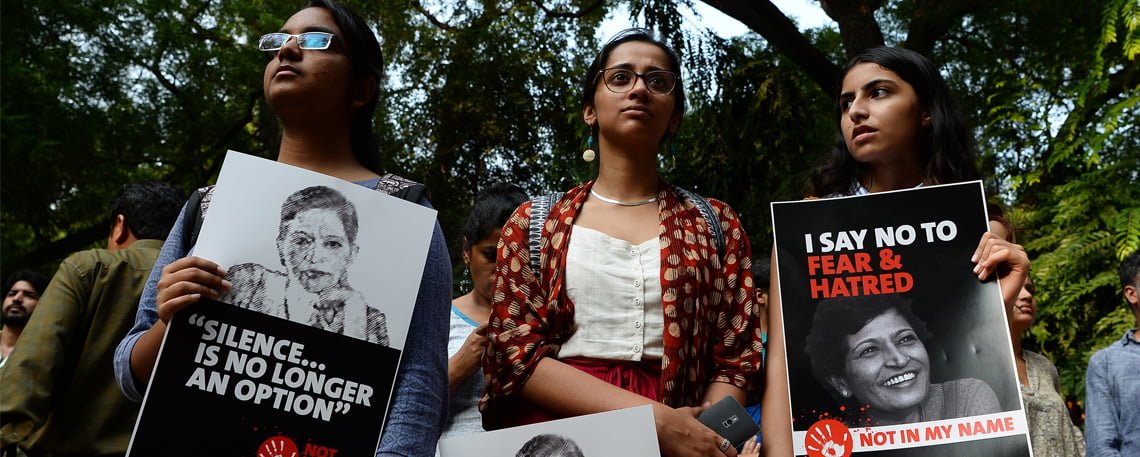According to the 2023 World Press Freedom Index, a report by the international media watchdog, Reporters Without Borders (RSF), India slipped to the rank of 161 out of 180 countries. India’s position on the press freedom index has demonstrated a consistent deterioration of the state of media freedom. The slip has been especially drastic this year, which showed India dipping by 8 per cent as opposed to around 2-3 per cent every year since 2017.
The current state of media in India
In this context, in a timely media survey presented in the Lokniti-CSDS report ‘Media in India: Trends and Patterns’, 206 journalists were surveyed. This provided insight into the perceptions of media and independent journalists regarding the current state of media in India. Surveyed across different mediums (TV, print, and digital), age groups, languages, gender, and level of seniority, the report dealt with some important themes, such as professional well-being, mental and physical health of journalists, perceptions of media representation, harassment, and press freedom.

75 per cent of the journalists surveyed were male. Of the female journalists surveyed, 85 per cent of the reported the adverse influence of their job on their mental health, while the figure was 66 per cent for male journalists. 60 per cent of the journalists claimed that they were asked to leave by their respective organsiations for cost-cutting purposes, and 75 per cent of the journalists feared that they would be asked to leave for the same. 73 per cent of journalists were of the opinion that media houses presented a single political party too favourably, out of which 85 per cent believed that the party the media houses favoured was the BJP, while only 3 per cent were of the opinion that the party was Congress.
This figure representing favouritism rose to 89 per cent in the case of independent journalists. Around 72 per cent of the journalists believed that the freedom of news channels was curbed. The figures for print and digital media were 55 per cent and 36 per cent respectively. 16 per cent of the respondents claimed they were asked to leave their media organisations due to their political leanings, while over half the journalists feared losing their jobs due to the same reason. Strikingly, over half of the journalists surveyed admitted contemplating leaving their jobs to pursue some other profession, which demonstrated a ‘deep-rooted dissatisfaction with the profession‘.
16 per cent of the respondents claimed they were asked to leave their media organisations due to their political leanings, while over half the journalists feared losing their jobs due to the same reason. Strikingly, over half of the journalists surveyed admitted contemplating leaving their jobs to pursue some other profession, which demonstrated a ‘deep-rooted dissatisfaction with the profession‘.
Analysing the situation of media freedom in India
These astounding figures should not come as a surprise in the larger context of the state of news media in India. A study published in 2021 showed how impunity was a tool that the state used in order to achieve ‘journalistic self-censorship‘, which undermined the institution of journalism as the fourth pillar of democracy. India was one of the countries where journalists were interviewed for the study.
A study published in 2021 showed how impunity was a tool that the state used in order to achieve ‘journalistic self-censorship‘, which undermined the institution of journalism as the fourth pillar of democracy. India was one of the countries where journalists were interviewed for the study.
Respondents identified certain issues that forced independent journalists to censor themselves on issues related to corruption, communal fights and religious issues, conflicts in Naxal areas and Kashmir, and unfavourable stories around prominent figures in power. One journalist pointed out that ‘the mafia has the police on their payroll then no one can protect the journalist anyway‘. The lack of solidarity among journalists, the weaponsiation of the internet to harass and threaten journalists, the lack of laws protecting the rights of journalists, and the lack of support from employers meant journalists must self-censor in order to protect themselves.

A study published in May 2023 focused on ‘government crackdowns on journalists during the pandemic, in the context of already-declining press freedom.‘ Media houses critical of the government’s handling of the pandemic and crucial for disseminating information during the public crisis often became victims of Income Tax (IT) raids, examples being the Hindi language newspaper, Dainik Bhaskar and an independent news website, Newslaundry.
The weaponsiation of the pandemic to silence the media in India
Laws such as the Epidemic Diseases Act, 1897 and the Disaster Management Act, 2005 had been used very frequently during the pandemic to arrest and detain journalists without any basis, and the police and the judiciary were amply complicit in this. Another paper published in 2020 observed, ‘The current Indian People’s Party (BJP) government keeps pushing back the boundaries around freedom and democracy and how it would like to operate. Laws such as the UAPA are no longer being invoked in conflict zones alone — they are becoming a common tool in BJP-ruled states to intimidate dissenters.’
During the pandemic, the local/regional news organisations were increasingly targetted. They were crucial for democratic functioning at the grassroots level. These attacks usually do not get covered in mainstream media, which means very little public discussion surrounds them. Small news organisations do not have the financial resources to go to court and initiate legal proceedings. Owing to this, they remain vulnerable.

The killing of Gauri Lankesh, the constant harassment, trolling and threats against Rana Ayyub, and other similar experiences of female journalists, such as Sagarika Ghose and Kavitha Krishnan experience, is disturbing to say the least. This era of journalism in India is characterised by ‘internet Hindus‘ forming Twitter mobs to psychologically tear down journalists critical of the government or their Hindutva agenda. It is characterised by increasingly partisan and emotion-driven news channels that see the public not as citizens that need to remain aware but as customers that need to be entertained through sensationalism and heated exchanges.
This is an era characterised by the need for news channels to provide a false sense of security promoted by the glorification of leaders in power and uncritical praise of their policies. The national media, the “oppressed” Hindu men of the Twitter mobs, the government’s increasingly authoritarian orientation and their promise for a “pure” Hindu nation, the lack of protection of the rights of the journalists, increasing opacity of the government’s actions, and the complicity of law enforcement institutions in maintaining the status quo make for an extremely worrying state of affairs.
About the author(s)
Shakti (she/her) is an English major and an aspiring tea sommelier. She loves reading poetry and drama and can be found with a Kindle most time. She intends to become a teacher of humanities and is passionate about literature, films, politics, and history. In her free time, she has been caught watching cringe content, however, she fervently denies these claims.






